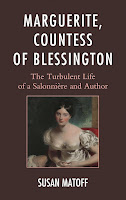Lady Blessington’s Neapolitan Journals
Irish aristocrat fell in love with Naples
Marguerite, Lady Blessington, an Irish-born writer who married into the British aristocracy, arrived in Naples on this day in 1823 and began writing her Neapolitan Journals. She was to stay in the city for nearly three years and her detailed account of what she saw and who she met has left a unique insight into life in Naples nearly 200 years ago. Lady Blessington made herself at home in Naples and thoroughly embraced the culture, attending local events, making what at the time were adventurous excursions, and entertaining Neapolitan aristocrats and intellectuals at the former royal palace that became her home. Those who know Naples today will recognise in her vivid descriptions many places that have remained unchanged for the last two centuries. She also provides a valuable insight into what life was like at the time for ordinary people as well as for the rich and privileged. Read more…
______________________________________
Michele Casadei Massari - chef and restaurateur
American dream from small beginnings
The chef and businessman Michele Casadei Massari, owner and founder of the Piccolo Cafe and the Lucciola restaurant in New York City, was born on this day in 1975 in Riccione, on the Adriatic coast of Emilia-Romagna. Massari had planned to become a doctor but abandoned his studies in order to pursue his dream of cooking in his own restaurant. After working as general manager and executive chef of a restaurant at a holiday resort in Sardinia, Massari and an old school friend decided to go it alone and chose to start a business in New York. They began by selling coffee from a kiosk on Union Square in Manhattan before graduating to a cafe selling traditional Italian food as well as salads, panini and egg dishes. Massari and his partner opened their first Piccolo Cafe in Third Avenue, a couple of blocks from Union Square in 2010. Read more…
Gino D'Acampo - celebrity chef
Neapolitan inherited talent from grandfather
The celebrity chef Gino D’Acampo was born on this day in 1976 in Torre del Greco, a conurbation of around 90,000 inhabitants within the Metropolitan City of Naples. Based in England since 1995, D’Acampo is scarcely known in his native country yet his social media pages have more than two and a half million followers. The author of numerous books on cooking, his many television appearances include several series of his own show, Gino’s Italian Escapes. He has owned a number of restaurants and pasta bars and has been the co-owner of a company selling Italian ingredients. His success is all the more remarkable given that he had to rebuild his life after being convicted in 1998 of burglary, an episode that took place while he was working as a waiter. He described the incident as a mistake he vowed never to repeat. Born Gennaro D’Acampo, he grew up around food. Read more…
______________________________________
Maria Salviati - noblewoman
Florentine whose line included kings of France and England
The noblewoman Maria Salviati, whose descendants include two kings of France and two kings of England, was born on this day in 1499 in Florence. Salviati was the mother of Cosimo I de’ Medici, the first Grand Duke of Tuscany and a powerful figure in the mid-16th century. Her descendants included Louis XIII and Louis XIV of France, and Charles II and James II of England. Married for nine years to Lodovico de’ Medici, who was more widely known as the condottiero Giovanni dalle Bande Nere, Salviati herself had Medici blood. One of a family of 10 children, her mother was Lucrezia de Lorenzo de’ Medici, who had married the politician Iacopo Salviati, who was from another major banking family in Florence. Maria’s maternal grandfather was Lorenzo the Magnificent, the Renaissance ruler who famously sponsored Michelangelo and Botticelli. Read more…
______________________________________
Book of the Day: Marguerite, Countess of Blessington: The Turbulent Life of a Salonniere and Author, by Susan Matoff
Marguerite, Countess of Blessington is the first biography of Lady Blessington in more than 80 years, illuminating the private and public life of this important but neglected salonnière and author. This study enriches our knowledge of the social, political, and literary history of the post-Romantic and early Victorian era. It examines Lady Blessington's close friendships with politicians and writers, especially Edward Bulwer Lytton and Benjamin Disraeli. Statesmen, diplomats, writers, and artists were her constant visitors, as they found her friendship and conversation invaluable to their professional and social lives. The circumstances of a life lived in luxury and indulgence changed upon the death of Lady Blessington's husband, forcing her to support herself and several dependents with her writing. This book reveals the humanity of a woman whom contemporary gossip considered scandalous because of her alleged relationship with her stepdaughter's estranged husband, Count D'Orsay. Lady Blessington's struggle in the face of many challenges is an inspiring story of individual strength.
Susan Matoff is an independent scholar with an MA in English Literature from the University of London, who subsequently studied social history and wrote research papers for the Bushey Museum in the United Kingdom. She is also the author of William Jerdan, 1782-1849: London Editor, Author and Critic.
%20(1).jpg)









%20(1).png)



.jpg)
.jpg)

.jpg)


